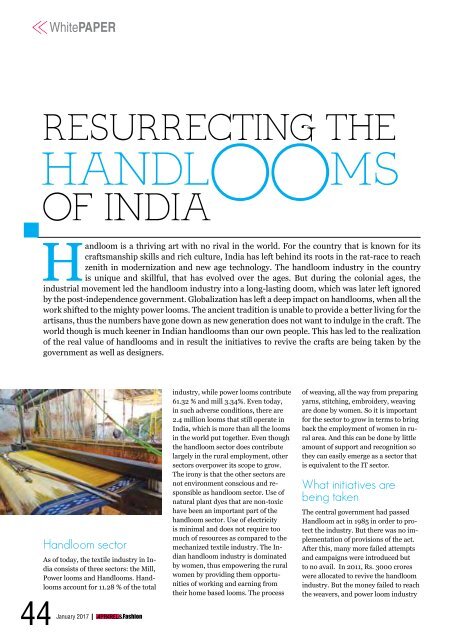Create successful ePaper yourself
Turn your PDF publications into a flip-book with our unique Google optimized e-Paper software.
WhitePAPER<br />
Resurrecting the<br />
handloo ms<br />
of <strong>India</strong><br />
Handloom is a thriving art with no rival in the world. For the country that is known for its<br />
craftsmanship skills and rich culture, <strong>India</strong> has left behind its roots in the rat-race to reach<br />
zenith in modernization and new age technology. The handloom industry in the country<br />
is unique and skillful, that has evolved over the ages. But during the colonial ages, the<br />
industrial movement led the handloom industry into a long-lasting doom, which was later left ignored<br />
by the post-independence government. Globalization has left a deep impact on handlooms, when all the<br />
work shifted to the mighty power looms. The ancient tradition is unable to provide a better living for the<br />
artisans, thus the numbers have gone down as new generation does not want to indulge in the craft. The<br />
world though is much keener in <strong>India</strong>n handlooms than our own people. This has led to the realization<br />
of the real value of handlooms and in result the initiatives to revive the crafts are being taken by the<br />
government as well as designers.<br />
44<br />
Handloom sector<br />
As of today, the textile industry in <strong>India</strong><br />
consists of three sectors: the Mill,<br />
Power looms and Handlooms. Handlooms<br />
account for 11.28 % of the total<br />
January 2017<br />
APPAREL&Fashion<br />
industry, while power looms contribute<br />
61.32 % and mill 3.34%. Even today,<br />
in such adverse conditions, there are<br />
2.4 million looms that still operate in<br />
<strong>India</strong>, which is more than all the looms<br />
in the world put together. Even though<br />
the handloom sector does contribute<br />
largely in the rural employment, other<br />
sectors overpower its scope to grow.<br />
The irony is that the other sectors are<br />
not environment conscious and responsible<br />
as handloom sector. Use of<br />
natural plant dyes that are non-toxic<br />
have been an important part of the<br />
handloom sector. Use of electricity<br />
is minimal and does not require too<br />
much of resources as compared to the<br />
mechanized textile industry. The <strong>India</strong>n<br />
handloom industry is dominated<br />
by women, thus empowering the rural<br />
women by providing them opportunities<br />
of working and earning from<br />
their home based looms. The process<br />
of weaving, all the way from preparing<br />
yarns, stitching, embroidery, weaving<br />
are done by women. So it is important<br />
for the sector to grow in terms to bring<br />
back the employment of women in rural<br />
area. And this can be done by little<br />
amount of support and recognition so<br />
they can easily emerge as a sector that<br />
is equivalent to the IT sector.<br />
What initiatives are<br />
being taken<br />
The central government had passed<br />
Handloom act in 1985 in order to protect<br />
the industry. But there was no implementation<br />
of provisions of the act.<br />
After this, many more failed attempts<br />
and campaigns were introduced but<br />
to no avail. In 2011, Rs. 3000 crores<br />
were allocated to revive the handloom<br />
industry. But the money failed to reach<br />
the weavers, and power loom industry


